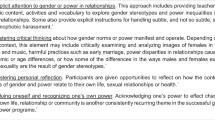Abstract
The college student population is among the highest risk group for contracting sexually transmitted infections (STIs) such as gonorrhea, chlamydia, and HIV. Safe sex practices, which are intended to mitigate risks associated with sexually transmitted infections, are often negated in the population of heterosexual college students. Historically, research on safe sex practices has shown that the burden of behavior change and the focus on educational efforts historically fall onto the female population. There is little published on how safe sex education for males impacts attitudes and behaviors towards safe sex practices. This community-based participatory research (CBPR) project explored heterosexual college male attitudes and behaviors about safe sex responsibilities with the goal of creating effective health promotion messages to increase safer sex. The research team comprised almost entirely of undergraduate male students, which strengthened the design and translation of results to practice. A mixed methods design was employed utilizing both focus groups and surveys as data collection (n=121). Results showed that young men are still prioritizing pregnancy prevention over disease contraction and/or testing, and relying on female partners to initiate safe sex. Implications for health promotion practice efforts on college campuses include: male-led peer education programming and support and messaging around screening and prevention of STIs.
Similar content being viewed by others
References
Centers for Disease Control and Prevention. HIV Surveillance Report, (2020). vol. 33. Retrieved August 10, 2022, from https://www.cdc.gov/hiv/library/reports/hiv-surveillance.html
Centers for Disease Control and Prevention (2022). HIV by Age: HIV Diagnoses. Retrieved September 1, 2022, from https://www.cdc.gov/hiv/group/age/diagnoses.html
American College Health Association. ACHA-National College Health Assessment II (2022). Reference Group Executive Summary. http://www.achancha.org/docs/ACHA-NCHA-II_ReferenceGroup_ExecutiveSummary_Fall2021.pdf. Accessed July, 28,
Breny Bontempi, J., Mugno, R., Bulmer, S., Danvers, K., & Vancour, M. (2009). Exploring gender differences in the relationship between HIV/STI testing and condom use among undergraduate college students. American Journal of Health Education, 41(2), 97–105.
Amaro, H., & Hardy-Fanta, C. (1995). Gender relations in addiction and recovery. Journal of Psychoactive Drugs, 27(4), 325–337.
Pulerwitz, J., Amaro, H., DeJong, W., Gortmaker, S. L., & Rudd, R. (2002). Relationship power, condom use, and HIV risk among women in the USA. Aids Care, 14(5), 789–800.
Breny, J. M., & Lombardi, D. C. (2017). I don’t want to be that guy walking in the feminine product aisle’: A photovoice exploration of college men’s perceptions of safer sex responsibility. Global Health Promotion, 26(1), 6–14. https://doi.org/10.1177/1757975916679362
James-Hawkins, L., Dalessandro, C., & Sennott, C. (2019). Conflicting contraceptive norms for men: Equal responsibility versus women’s bodily autonomy. Culture, Health & Sexuality, 21(3), 263–277. https://doi.org/10.1080/13691058.2018.1464209
Stanley, S. J., Kim, S., & Pitts, M. J. (2018). Gender norms and Discourses Informing College Men’s perceptions of heteronormative sexual Health Responsibilities and HPV Prevention. Communication Quarterly, 66(3), 225–244. https://doi.org/10.1080/01463373.2017.1356338
Dalessandro, C., James-Hawkins, L., & Sennott, C. (2019). Strategic silence: College Men and Hegemonic masculinity in contraceptive decision making. Gender & Society, 33(5), 772–794. https://doi.org/10.1177/0891243219850061
Fefferman, A. M., & Upadhyay, U. D. (2018). Hybrid masculinity and young Men’s Circumscribed Engagement in Contraceptive Management. Gender & society: official publication of Sociologists for Women in Society, 32(3), 371–394. https://doi.org/10.1177/0891243218763313
Wallerstein, N., Doran, B., Oetzel, J., & Minkler, M. (2018). Community-based Participatory Research for Health: From process to outcomes (3rd ed.). San Francisco, CA: Jossey-Bass Publishers.
Wilson, N., Minkler, M., Dasho, S., Wallerstein, N., & Martin, A. C. (2006). Getting to social action: The Youth empowerment strategies (YES!) Project. Health Promotion Practice, 9(4), 395–403.
Coombe, C. M., Chandanabhumma, P. P., Bhardwaj, P., Brush, B. L., Greene-Moton, E., Jensen, M., Lachance, L., Lee, S. Y. D., Meisenheimer, M., Minkler, M., Muhammad, M., Reyes, A. G., Rowe, Z., Wilson-Powers, E., & Israel, B. A. (2020). A participatory, mixed methods Approach to define and measure Partnership Synergy in Long-standing equity-focused CBPR partnerships. American Journal of Community Psychology, 66(3–4), 427–438. https://doi.org/10.1002/ajcp.12447
Carmack, C., Roncancio, A. M., Gerecht, L., & Ansari, M. (2020). Perceived partner beliefs about condoms and self-efficacy communication within the context of the theory of gender and power. Journal of Community Psychology, 48(5), 1424–1437. https://doi.org/10.1002/jcop.22337. https://doi-org.scsu.idm
Wong, T., Pharr, J. R., Bungum, T., Coughenour, C., & Lough, N. L. (2019). Effects of peer sexual Health Education on College Campuses: A systematic review. Health Promotion Practice, 20(5), 652–666. https://doi.org/10.1177/1524839918794632. https://doi-org.scsu.idm
Butler, S. M., Hartzell, R. M., Przybyla, S., & Bock, L. B. B. (2006). Moving beyond peer education: Using peer advocates to increase condom availability on College Campuses. Perspectives in Peer Programs, 20(2), 40–45.
Author information
Authors and Affiliations
Corresponding author
Ethics declarations
Conflict of Interest
The authors have no conflicts of interest to report.
Ethical approval
This study was approved by the Institutional Review Board at Southern Connecticut State University.
Informed consent
Informed consent was received from all participants.
Consent to publish
Consent to publish was received from participants.
Additional information
Publisher’s Note
Springer Nature remains neutral with regard to jurisdictional claims in published maps and institutional affiliations.
Electronic Supplementary Material
Below is the link to the electronic supplementary material.
Rights and permissions
Springer Nature or its licensor (e.g. a society or other partner) holds exclusive rights to this article under a publishing agreement with the author(s) or other rightsholder(s); author self-archiving of the accepted manuscript version of this article is solely governed by the terms of such publishing agreement and applicable law.
About this article
Cite this article
Breny, J.M., Joseph, M., Robledo, D. et al. Exploring What Influences Heterosexual College Men and the Practice of Safe Sex: The Power of Stigma and Community. J Community Health 48, 870–877 (2023). https://doi.org/10.1007/s10900-023-01220-w
Accepted:
Published:
Issue Date:
DOI: https://doi.org/10.1007/s10900-023-01220-w




